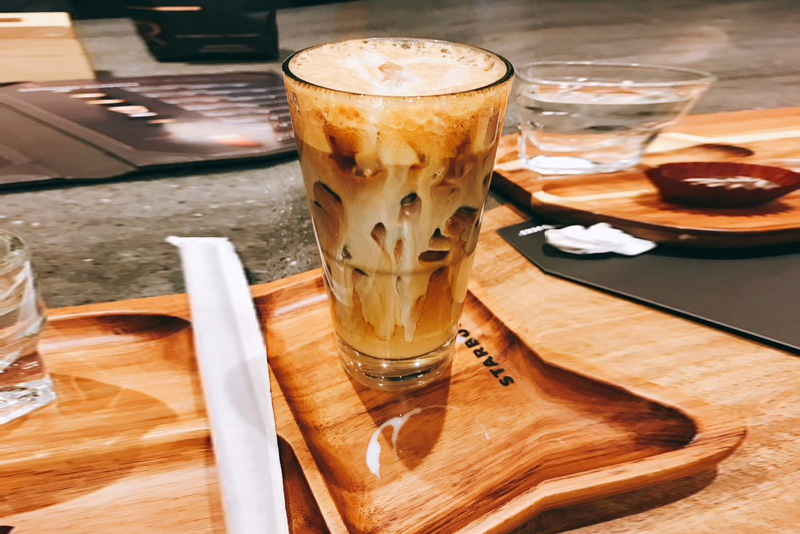The Black Eagle has landed at Starbucks Reserve


Drinkable dessert: Starbucks Reserve’s Shakerato Bianco Photos by Therese Jamora-Garceau
For a coffee lover like myself, visiting a Starbucks Reserve store is like dying and going to heaven. There, in a beautifully designed environment, rare, small-lot, extremely special coffees like Jamaica Blue Mountain are served in ways that make you think: “So this is coffee,” and make you feel like a java virgin all over again.
It’s coffee nerd-ism at its finest, with techie gadgets like an Acaia scale attached to an iPad to weigh coffee and time manual brewing precisely, and is run by Global Coffee Masters and barista champions who really know their stuff but better yet, know how to get you passionate about what they know.
Starbucks Philippines recently held a tasting at its Reserve store in Power Plant Mall (you’ll know it’s Reserve if you see a gold star over the letter “R” on the wall), which also happens to be their 20th-anniversary store, and it’s a beaut, with Benguet-inspired interiors, lots of curvy blond wood, and a spacious “Reserve Bar” where baristas showcase various manual brewing methods like pour-over, siphon and Chemex.
Off to the side sits the sleek, space-aged contraption that is one of the reasons we’re here today: it’s the Black Eagle, a state-of-the-art espresso machine made by Italian company Victoria Arduino, and so high-tech as to be able to hold two different kinds of beans and thus produce two different kinds of espresso shots at the same time.
“We fell in love with this machine because the Black Eagle was originally created for specialty coffee,” says Victor “Third” Villaflor III, Starbucks Philippines’ Coffee Ambassador for 2013 and part of the brand’s Coffee Leadership Team in the Philippines. “For Starbucks, our specialty coffee is Reserve coffee, which is limited, we get from small farms, rare, and they usually give us different flavors,” he explains.
Villaflor and Asia-Pacific regional barista champion Miguel Bautista are the captains of our coffee journey, the main actors in the “coffee theater” being staged today. Our tasting will take us through five beverages that will clarify what Starbucks Reserve and the Black Eagle are all about.
Beverage 1: Starbucks Reserve Jamaica Blue Mountain
What it is: A very premium, pricey coffee sourced from the Amber Estate, which sits 7,500 feet high on Jamaica’s Blue Mountain. They don’t normally serve it as a beverage at Starbucks Reserve; it’s available only as a bag of whole beans for P2,495.
What makes it so special: Its rarity and complex flavors. Jamaica produces around five million pounds of coffee a year — a minuscule amount compared to neighboring Dominican Republic, which produces 113 million pounds a year.
“The thing is, 80 percent of that five million is automatically shipped to Japan, the biggest market for Jamaican Blue Mountain,” explains Villaflor. “The other 20 percent is what they distribute to the rest of the world.”
The Amber Estate’s high elevation also means the normal nine-month growth cycle of the coffee cherries extends up to 10 months, resulting in more complexly flavored cherries but also a longer waiting time before harvest. Harvesting is no walk in the park, either, as the slopes of the Blue Mountain can be up to 70 degrees steep.
Lastly, this coffee is closely monitored at every stage of growth, from planting to harvest, and rivals French wine in terms of its Appellation d’origine contrôlée. Certified tasters cup samples at the Coffee Industry Board of Jamaica before they deem it good enough to carry the Jamaica Blue Mountain name.
Brewing method: Villaflor brews it using the pour-over cone filter, though he recommends French press for easy brewing at home. “It’s not going to give you the same flavor because of the different brewing process, it’s going to be even more complex,” he says. “Different brewing methods give you different experiences.”
Aromas: While Villaflor got roast-y, nutty, and chocolate-y aromas from the beans, I was like Thomas Haden Church in Sideways, struggling to detect anything other than “roast-y.” Once ground, the coffee yielded even more aromas, releasing citrusy notes. Thankfully I was able to smell the tartness this time.
How it tastes: Villaflor instructs us to slurp our coffee so as to incorporate air and spread the coffee all over the tongue and taste buds. “It’s very citrusy upon slurping, but are you also getting a hint of sweetness?” he asked us. I was. “It’s also giving a dry-cocoa mouth feel. As it cools down it gives you different layers of flavor, so we can really call this coffee ‘complex.’”
Beverage 2: Shakerato Bianco Deconstructed (Tall P190, Grande P205)
What it is: One of the three beverages on Starbucks Reserve’s “New Tradition” menu — handcrafted espresso beverages that highlight their rare, small-lot coffees in extraordinary ways — this drink consists of espresso shots made from Honduras La Campa, a plummy, red-currant-y Central American coffee shaken with ice, Demerara syrup, and served with a half ounce of vanilla-bean sweet cream on the side.
Flavors: You know that heavenly smell of brewing coffee that never seems to be replicated in the cup? The deconstructed Shakerato is that heavenly smell materialized.
“The beverage gives you a plum-like or orange sweetness,” notes Villaflor. “Are you getting the sweet orange notes? Once you’ve tried it as is, I recommend you put in the vanilla-bean sweet cream.”
I did and, though I almost prefer it pure, the sweet cream transforms the coffee into a creamy, salted caramel dessert. This was my favorite drink of the morning.
Beverage 3: Shakerato Bianco (Tall P190, Grande P205)
What it is: The original Shakerato is espresso with the vanilla sweet cream already mixed in and shaken with ice.
How it tastes: In its constructed form, Shakerato Bianco is a sweet, creamy, drinkable dessert that highlights the rich, caramel flavors of the coffee.
Beverage 4: Vanilla Bean Latte (Tall P200, Grande P215)
What it is: Vanilla Bean syrup and Starbucks Reserve espresso are combined with steamed micro-foam milk and finished with latte art. Also available iced.
Asia-Pacific barista champion Miguel Bautista, 24, did our latte art, which ranged from a simple heart to an elaborate swan. “These are the actual beverages that Starbucks serves in their Seattle Roastery,” said Bautista as he handed me my latte.
How it tastes: I love both lattes and vanilla so for me, this is the apex of what a latte can be and should taste like.
Beverage 5: Cortado (Doppio P175)
What it is: A beverage on the “Espresso Classics” side of Starbucks Reserve’s menu, this is crafted from two espresso shots using Honduras La Campa with an equal amount of steamed milk.
How it tastes: Like a coffee connoisseur’s drink. “The milk adds more texture and creaminess, but when you sip it you really taste the La Campa,” Villaflor observes. “It’s a perfect balance between the citrus notes of the coffee and the creaminess of the milk.”
* * *
Starbucks Reserve is located at Power Plant Mall and The Podium. A new branch will open soon in Stratosphere, Valero St., Makati.
* * *
Follow me on Facebook (Therese Jamora-Garceau), Twitter @tjgarceau and Instagram @theresejamoragarceau.



















